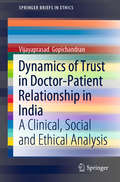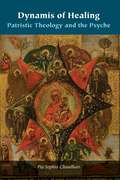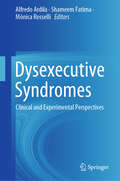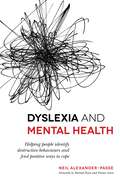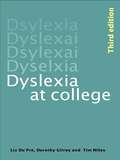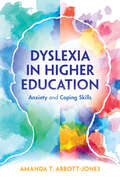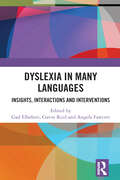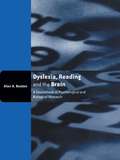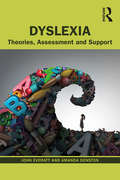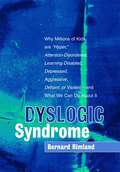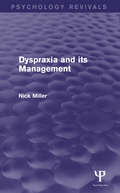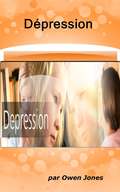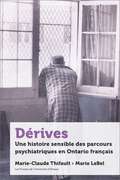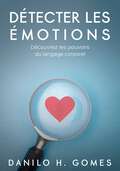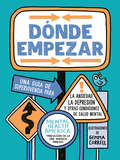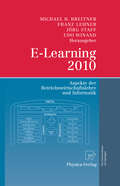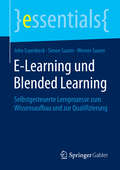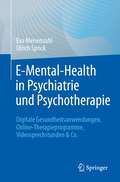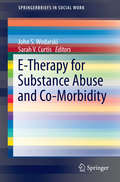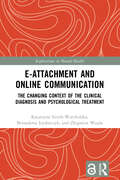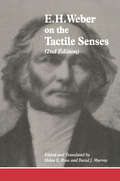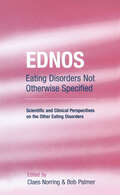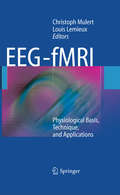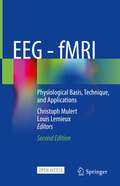- Table View
- List View
Dynamics of Trust in Doctor-Patient Relationship in India: A Clinical, Social and Ethical Analysis (SpringerBriefs in Ethics)
by Vijayaprasad GopichandranThis book offers an easy-to-read, yet comprehensive introduction to practical issues in doctor–patient relationships in a typical low- and middle-income country setting in India, examining in detail the reasons for erosion of trust and providing guidance on potential research areas in the field. It strikes a balance between empirical work and theoretical normative analysis, while adopting mixed-method research in exploring important constructs in the doctor–patient relationship, such as trust, solidarity, advocacy, patient-centeredness, privacy, and confidentiality. Since the concept of trust has direct implications for the ethical practice of medicine, the book is a valuable resource for academics and researchers in the field of medical, clinical, and applied ethics.
Dynamis of Healing: Patristic Theology and the Psyche (Orthodox Christianity and Contemporary Thought)
by Pia Sophia ChaudhariThis book explores how traces of the energies and dynamics of Orthodox Christian theology and anthropology may be observed in the clinical work of depth psychology. Looking to theology to express its own religious truths and to psychology to see whether these truth claims show up in healing modalities, the author creatively engages both disciplines in order to highlight the possibilities for healing contained therein. Dynamis of Healing elucidates how theology and psychology are by no means fundamentally at odds with each other but rather can work together in a beautiful and powerful synergia to address both the deepest needs and deepest desires of the human person for healing and flourishing.
Dysexecutive Syndromes: Clinical and Experimental Perspectives
by Alfredo Ardila Mónica Rosselli Shameem FatimaThe concept of executive functioning has become central in understanding normal and abnormal cognitive processes. This timely volume analyzes the diverse conditions that can result in executive function disturbances, providing research about underlying causes, exploring the differences between developmental and acquired executive "dysfunctions," and providing approaches for the assessment of executive dysfunction both in children and in adults. In doing so, it addresses a gap in the literature in its analysis of executive function deficits and their link with psychopathology in psychiatric patients for the management of clinical symptoms and social adjustment.Among the specific topics examined: Theoretical approaches for the analysis of the diverse dysexecutive syndromes Common executive dysfunction syndromes found during childhood development: attention deficit hyperactivity disorder and autism spectrum disorders Consequences of executive function deficits in the use of information technology Executive dysfunction and personality disorders Common executive function tests, assessment issues in executive dysfunction, and cross-cultural and bilingual questions in assessment of executive dysfunction Dysexecutive Syndromes: Clinical and Experimental Perspectives expertly extends the analysis of executive functions and dysfunctions from a fundamental and clinical perspective. It is essential reading for clinical psychologists, neuropsychologists, neurologists, and psychiatrists, and graduate and post-graduate students in psychology, neurology, and the health neurosciences, as well as clinicians, counselors, and psychometricians working with neuropsychiatric assessment.
Dyslexia and Mental Health: Helping people identify destructive behaviours and find positive ways to cope
by Michael Ryan Neil Alexander-Passe Pennie AstonDyslexia is a complex condition that affects not only learning but every part of life. Experience or fear of social stigma can lead people with dyslexia to camouflage the difficulties they face, to withdraw and to adopt negative coping strategies, particularly if they lack adequate support, identification and intervention. This can have lasting impact on their emotional health. Neil Alexander-Passe is an experienced researcher and a special needs teacher in secondary mainstream education. He also has dyslexia. Neil uses his personal and professional experience to shed light on the complexities surrounding dyslexia and examines psychological theories such as ego-defence mechanisms and learned helplessness that reveal how people deal with its emotional impact. He offers guidelines and advice, illustrated with real life examples, about how to help people with dyslexia avoid harmful coping strategies and learn to deal with stress, anxiety and low self-esteem in more effective and psychologically positive ways. This book will help educational and clinical psychologists, teachers, mental health specialists, counsellors and therapists understand the emotional complexities of dyslexia.
Dyslexia at College
by T. R. Miles Dorothy Gilroy Elizabeth Ann Du PreThis fully updated third edition contains practical and useful advice that will be invaluable for students with dyslexia, their parents and all of those involved in teaching and supporting them in their studies. Including the latest research into dyslexia, changes in legislation and information technology and the real-life experiences of six former Bangor students this book will: • guide students through the process of applying for university, suggesting strategies for general organisation and for particular aspects of study • outline how to get the best personally and academically from higher education • give practical advice on setting up and using support facilities (both human and technological) • be an accessible text for mainstream lecturers and tutors who need to be aware of the implications of the Disability Discrimination Act. New chapters include 'Dyslexia plus', giving information on dyspraxia, attention disorders, Asperger's syndrome, and the more controversial 'dyscalculia'. ‘Out of College and into Work’ gives advice for students on the challenges they face after graduation.
Dyslexia in Higher Education: Anxiety and Coping Skills
by Amanda T. Abbott-JonesPeople can best help dyslexic students once they understand dyslexia's association with anxiety and effective coping strategies, both cognitively and emotionally. By highlighting the perspectives of dyslexic students, this book evidences the prevalence of anxiety in dyslexic communities. The shared experience from a range of dyslexic learners pinpoints best practice models and helps combat the isolation felt by many with learning difficulties. The author targets academic areas where students struggle, offering techniques to overcome these barriers. Such obstacles are not always due to cognitive factors but may be associated with negative experiences, leading to fear and uncertainty. Recounting these sticking points through student voices, rather than from a staff viewpoint, enables readers to find meaningful solutions to dyslexia-related problems. Through this dynamic methodology, the book shows researchers and practitioners how to understand dyslexic needs on an emotional level, while presenting dyslexic readers with practical coping methods.
Dyslexia in Many Languages: Insights, Interactions and Interventions
by Gavin Reid Gad Elbeheri Angela FawcettDyslexia in Many Languages thoroughly investigates the fascinating relationship between dyslexia and language systems by highlighting research and practice initiatives around the world.Focusing on how dyslexia manifests itself in non-English languages, readers of this text will enhance their understanding and appreciation for the role of language systems and the interplay they have with dyslexia, assessment and intervention. Experienced and expert contributors around the world consider how dyslexia is defined, assessed, and supported in their native country, drawing on the linguistic features of that language and how this affects monolingual, bilingual and multilingual speakers. This book also compares dyslexia in different languages and questions what are the universal lessons that we can learn from comparing dyslexia in different languages and do different languages affect its prevalence and incidence? The editors consider the implications for classroom practice, such as learning and teaching challenges, the social emotional and educational impact on the child as a learner and considers the various sides of the educational process of students with dyslexia in different languages.This volume is essential reading for teachers and psychologists who deal with a large number of students and patients coming from different language backgrounds. Researchers and educators interested in dyslexia in different languages will also find its contents useful and relevant in their learning and work contexts.
Dyslexia, Reading and the Brain: A Sourcebook of Psychological and Biological Research
by Alan BeatonDespite the wealth of literature available on the subject of dyslexia, there is little that explores the subject beyond a single theoretical framework. The need for a comprehensive review of the literature by both researchers and practitioners from different fields and theoretical backgrounds is the central motivation behind Dyslexia, Reading and the Brain. By combining the existing fragmented and one-sided accounts, Alan Beaton has created a sourcebook that provides the much-needed basis for a more integrated and holistic approach to dyslexia.The book is divided into two sections: the first, The Cognitive Context, outlines the theoretical context of normal reading development and introduces the role of phonological awareness and the relation between dyslexia and IQ. Section two, The Biological Context, provides an explanation of the genetic background as well as exploring hormonal theories and the visual aspects of dyslexia.
Dyslexia, Reading and the Brain: A Sourcebook of Psychological and Biological Research
by Alan BeatonDespite the wealth of literature available on the subject of dyslexia, there is little that explores the subject beyond a single theoretical framework. The need for a comprehensive review of the literature by both researchers and practitioners from different fields and theoretical backgrounds is the central motivation behind Dyslexia, Reading and the Brain. By combining the existing fragmented and one-sided accounts, Alan Beaton has created a sourcebook that provides the much-needed basis for a more integrated and holistic approach to dyslexia.The book is divided into two sections: the first, The Cognitive Context, outlines the theoretical context of normal reading development and introduces the role of phonological awareness and the relation between dyslexia and IQ. Section two, The Biological Context, provides an explanation of the genetic background as well as exploring hormonal theories and the visual aspects of dyslexia. By including both historical theories and some of the most recent developments, Dyslexia, Reading and the Brain succeeds in presenting the reader with a balanced and unbiased overview of the current thinking and achieves a unique breadth and depth of coverage. The comprehensive coverage and impartial approach mean that this sourcebook will prove an invaluable resource for anyone involved in study, research or practice in the fields of reading and dyslexia.
Dyslexia: Theories, Assessment and Support
by John Everatt Amanda DenstonDyslexia: Theories, Assessment and Support offers a broad perspective on dyslexia, providing a range of views from theory to practice which help explain the continued controversy surrounding the condition. Offering a framework on which to understand the concept of dyslexia, the book considers procedures that can both identify the condition and help support those with it. With a focus on self-concept, the authors highlight ways to positively influence both literacy acquisition and individual well-being. This book is ideal reading for those taking courses on dyslexia or literacy learning difficulties within education, psychology and related disciplines. It will be of great interest to specialist teachers, special education staff, educational psychologists and those in related occupations.
Dyslogic Syndrome: Why Millions of Kids are "Hyper," Attention-Disordered, Learning Disabled, Depressed, Aggressive, Defiant, or Violent - and What We Can Do About It
by Bernard RimlandDyslogical children are commonly labelled as having one or more of a mix of conditions that include Attention Deficit/Hyperactivity Disorder, Conduct Disorder, Bipolar Disorder and Oppositional Defiant Disorder. The number of children who could be described as dyslogical continues to rise sharply, and society has a tendency to lay the blame for this trend on poor parenting or bad schooling. In this ground-breaking book, Bernard Rimland argues that such `conventional wisdom' is not just mistaken but dangerous. Drawing on the latest research, Rimland outlines the impact of biological factors on today's children and exposes the influences of toxins and dietary deficiencies. Dyslogic Syndrome is full of valuable advice on the safe, effective treatments that are available to children, and offers positive strategies for helping parents and professionals to do the best for their dyslogical child.
Dyspraxia and its Management (Psychology Revivals)
by Nick MillerDyspraxia is a disorder of voluntary, purposeful, learned movement and is one of the most common sequelae of stroke, head-injury, neoplasm and abnormal ageing. It is also a major complicating factor in the assessment and treatment of acquired language, visual-spatial and other movement disorders. Dyspraxics are found not only in specialist neurological units, but also in rehabilitation centres, general medical and surgical wards, geriatric units and in the community. Despite this there was little systematic discussion of dyspraxia in major texts on stroke, head injury, rehabilitation or movement disorders at the time. Originally published in 1986, one aim of this book was to correct the imbalance in the attention paid to the disorder. The emphasis of the book is practical, dealing with the recognition and assessment of dyspraxic dysfunction, and guidelines and issues in its remediation. Theoretical issues are covered in relation to their bearing on clinical management. It was the standard textbook on the topic for many years and directly relevant at the time to clinicians in the fields of clinical psychology, occupational therapy and physiotherapy, speech therapy, neurology and geriatrics.
Dépression: Quand vous sentez que tout est perdu ... (Comment faire... #77)
by Owen JonesDépression Quand vous sentez que tout est perdu ... Dépression ... ce sentiment destructeur de l’âme qu'il ne reste plus rien à espérer. Bonjour et merci d’avoir acheté ce livre numérique intitulé ‘Dépression’. J'espère que vous trouverez les informations utiles, utiles et bénéfiques. J’aimerais mentionner que j’ai écrit ce libre après avoir fait de longues recherches sur le sujet. Je suis l’unique auteur de ce livre. Si vous découvrez que ce n’est pas vrai, je vous serais très reconnaissant si vous m’envoyez le URL du site incriminé pour que je puisse agir en conséquence. Les informations contenues dans ce livre numérique sur divers aspects de la dépression et des sujets connexes sont organisées en 15 chapitres d'environ 500 à 600 mots chacun. J'espère que cela intéressera ceux qui sont préoccupés par leurs problèmes de dépression sous toutes ses formes. Si vous avez des commentaires, veuillez les laisser à la société auprès de laquelle vous avez acheté ce livre. Vous pouvez également trouver plus de livres du même style sur d’autres sujets. Merci encore d'avoir acheté ce livre numérique, Cordialement, Owen Jones
Dérives: Une histoire sensible des parcours psychiatriques en Ontario français (21e – Société, histoire et cultures)
by Marie-Claude Thifault Marie LeBelDérives propose de plonger dans l’individuel, le personnel, l’intime et de suivre, presque au jour le jour, la vie d’êtres à la fois fragiles et résistants vivant sur la corde raide et pour qui, à tout instant, l’univers peut basculer. Des épisodes de chutes et de relèvement ont été minutieusement documentés pour reconstituer les parcours psychiatriques de six personnes, quatre femmes et deux hommes, originaires de l’Ontario français. Les récits d’enquêtes que nous proposons, sous le thème des dérives, sont basés sur des faits véridiques et notre démarche s’appuie sur la méthode historienne : la fouille, les rencontres, l’expérience, l’examen minutieux de données. Ce livre intéressera les chercheurs et les étudiants en sociologie, en anthropologie sociale et culturelle, en psychologie, en sciences infirmières, en travail social et en histoire, mais aussi un public curieux.
Détecter les émotions: Découvrez les pouvoirs du langage corporel
by Danilo H. GomesLe cerveau est sans aucun doute une machine incroyable et unique, mais il n'était pas programmé pour toujours agir de manière cachée. Même si vous pouvez mémoriser tous les détails de ce livre, soyez très prudent. Pas toujours ce qu'il semble, c'est. Une personne qui reste oisive tout en écoutant ses histoires peut être désintéressée, mais peut aussi être simplement froide. Le contexte dans lequel l'individu est inséré doit toujours être pris en compte. Avoir une bonne observation et interpréter facilement le langage corporel est une compétence dominée par peu et peut être une bonne arme utilisée pour le bien ou le mal.
Dónde empezar: Una guía de supervivencia para la ansiedad, la depresión y otras condiciones de salud mental (Where to Start Spanish Edition)
by Mental Health AmericaEmocionales y busque ayuda, de la principal organización comunitaria sin fines de lucro del país que se ocupa de las necesidades de quienes viven con una condición de salud mental. Ahora disponible en español.Puede ser extremadamente difícil averiguar qué nos pasa por la mente cuando estamos sufriendo, cuando nos sentimos solos e indignos y no podemos detener nuestra voz interior autocrítica. Y es aún más difícil saber dónde buscar respuestas. Este libro es un primer paso perfecto. Aquí encontrarás información clara, honesta y tranquilizadora sobre todas las condiciones de salud mental más comunes y sobre lo que puedes hacer para encontrar ayuda y practicar el autocuidado.Características de Dónde empezar (edición en español): • Información sin jerga sobre todas las condiciones de salud mental más comunes, incluida una primera prueba de autoevaluación• Consejos sobre cómo obtener ayuda profesional y cómo hablar de tu salud mental con amigos y familiares• Herramientas esenciales, como hojas de ejercicios [AB2] y contenido sobre salud mental para hacer por tu cuenta• Dibujos perspicaces y divertidos de la reconocida dibujante Gemma CorrellNow available in Spanish, a comforting and useful resource for anyone who&’s struggling emotionally and looking for help―from the nation&’s leading community-based nonprofit that addresses the needs of those living with mental illness.It can be extremely hard to figure out what&’s going on in our own heads when we are suffering—when we feel alone and unworthy and can&’t stop our self-critical inner voice. And it&’s even more difficult to know where to go for answers. This book is a perfect first step. Here you&’ll find clear, honest, reassuring information about all the most common mental illnesses and what you can do to find help and to practice self-care.Where to Start (Spanish edition) features:• Jargon-free information about all the most common mental illnesses, including a first self-assessment test• Tips on how to get professional help and how to talk about your mental health with friends and family• Essential tools, including handy worksheets and DIY mental health content• Insightful, funny drawings by acclaimed cartoonist Gemma Correll
E-Learning 2010
by Franz Lehner Jörg Staff Michael Breitner Udo WinandTechnologiebasiertes und mobiles Lernen und Lehren sind in der Informations- und Wissensgesellschaft von zentraler Bedeutung. Ziel des Sammelbandes ist es, einen Blick in die nahe Zukunft des E- und M-Learnings zu werfen: der lebenslangen Aus- und Weiterbildung vom Vorschul- bis ins Rentenalter unter Verwendung von Rechnern und Rechnernetzwerken. Bei der Entwicklung solcher Angebote kommt es vor allem darauf an, ganzheitliche, integrierte Ansätze zu finden, die die drei Säulen Technologie, Didaktik und Betriebswirtschaftslehre berücksichtigen.
E-Learning und Blended Learning: Selbstgesteuerte Lernprozesse zum Wissensaufbau und zur Qualifizierung (essentials)
by John Erpenbeck Werner Sauter Simon SauterDie Autoren beschreiben die Deutungen des Begriffes E-Learning und erläutern die Rahmenbedingungen sowie die Elemente von E-Learning Arrangements. Sie entwickeln ein praxiserprobtes Blended Learning Arrangement, das problemorientierte Workshops mit selbstgesteuertem Lernen auf der Basis von Web Based Trainings oder Lernvideos verknüpft. Erfolgsfaktoren für E-Learning und Blended Learning Arrangements werden analysiert, eine zuverlässige Konzeption der Lernbegleitung wird entwickelt. Die Autoren leiten zudem auf Basis ihrer langjährigen Projekterfahrung Fallstudien für E-Learning und Blended Learning in Verbindung mit Social Learning ab, welche sich durch eine konsequente Bedarfsorientierung, Effizienz und Wirtschaftlichkeit auszeichnen.
E-Mental-Health in Psychiatrie und Psychotherapie: Digitale Gesundheitsanwendungen, Online-Therapieprogramme, Videosprechstunden & Co
by Eva Meisenzahl Ulrich SprickDas Buch bietet einen Einblick in die Definition und Eigenschaften spezifischer digitaler Gesundheitsanwendungen (DiGAs) im Sektor Psychiatrie und Psychotherapie sowie die maßgeblichen Qualitätskriterien, die für Behandler und empfehlende Ärzte wichtig sind. Der Leser erfährt, welche digitalen Angebote es gibt und welche unterschiedlichen Formate genutzt werden können: Systematisch und präzise werden die verschiedenen, aktuell von Krankenkassen angebotenen digitalen Programme mit deren Einsatzgebieten vorgestellt. Ergänzt wird die Darstellung durch die wichtigen Themen der Kostenübernahmen, des Datenschutzes und der Sicherheit der Programme sowie die Wirksamkeit und Akzeptanz dieser modernen Verfahren.Darüber hinaus erläutern die Autoren das spezifische Konzept der Videosprechstunde und geben Hinweise zu dessen Abrechnungsformalitäten. Dieses hochaktuelle Kompendium ist für Psychiater, aber auch interessierte Ärzte anderer Fachrichtungen, Ärztliche Psychotherapeuten sowie Psychologen und Psychologische Psychotherapeuten sowie Fachpflege geeignet, um ihnen einen fachlichen und praktischen Überblick über dieses Themengebiet zu geben. Das Buch ist ein exzellenter Begleiter und zukünftiges „Must Have“ im Dickicht des modernen digitalen Zeitalters, wo sich der einzelne Behandler oft aus Zeitgründen in den unternehmerisch so wichtigen zukünftigen Themenbereichen nicht ausreichend informieren kann.
E-Therapy for Substance Abuse and Co-Morbidity
by John S. Wodarski Sarah V. CurtisThis brief provides an overview of the emerging field of Electronic Therapy, E-Therapy, with a specific focus on alcohol and substance abuse. Understanding barriers that prevent individuals from seeking necessary mental health treatment is at the center of the development and analysis of practice models of care. Geographic location, transportation, language barriers and other situations contribute to difficulties in obtaining adequate treatment for mental illness. E-Therapy eliminates these barriers by administering counseling and mental health services through audio or audiovisual means. This brief examines E-Therapy best practices as they apply to alcohol and substance abuse intervention and prevention.
E-attachment and Online Communication: The Changing Context of the Clinical Diagnosis and Psychological Treatment (Explorations in Mental Health)
by Bernadetta Izydorczyk Katarzyna Sitnik-Warchulska Zbigniew WajdaThis book examines the use of modern technologies in clinical psychological practice. It considers how we define attachment in an age where changes in technology and the COVID-19 pandemic have increased the prevalence of online contact in the process of diagnosis and psychological treatment. Based on an attachment paradigm that is relatively unexplored, the book outlines how modern online contact influences mental health and development, along with the therapeutic relationship between client and professional. It discusses people’s relationships with new technologies, how relationships can be established using these technologies, and how these technologies affect professional relationships between psychologists and their clients, which they define as e-attachment. In the context of new technologies, the book draws on neurobiology and clinical psychology to consider mental health, social functioning, and emotional regulation. Presenting both theory and examples from case studies, this cutting-edge book will be of great interest to researchers, academics, and post-graduate students in the fields of clinical psychology, psychotherapy, and mental health. Those also carrying out research into digital and online learning within the field of mental health will also benefit from this text.
E.H. Weber On The Tactile Senses
by E.H. WeberThis is a revised edition of "E.H. Weber: The Sense of Touch". The title has been broadened to reflect the fact that Weber explored all the skin senses - and indeed the muscle sense and that mysterious entity "the common feeling". The introduction has been expanded to include further information on Weber's life and times, and on recent research relevant to Weber's own work. The translations of Weber's main works of psychological interest "De Tactu" and "Der Tastsinn und das Gemeingefuehl" contain only minor changes, but the footnotes have been updated.; The reader will find here much more than those topics for which Weber is best known - the two-point threshold, experiments on weight discrimination, and a statement of what is now called Weber's Law. Weber also remarked on many aspects of sensory psychology - on left-right asymmetry in sensitivity, on visual resolution, the binocular combination of colours, the moon illusion, on summation, inhibition and adaptation in sensory systems, on the difference between simultaneous and successive presentations, on selective attention, the externalization of sensations and the difference between sensation and perception.
EDNOS: Scientific and Clinical Perspectives on the Other Eating Disorders
by Bob Palmer Claes NorringEating Disorders Not Otherwise Specified covers all eating disorders that do not fall into either of the two main diagnostic groups: anorexia nervosa and bulimia nervosa. Although these less well known conditions are common and can be very severe, they are often neglected. This book brings together contributions from many of the leading researchers and practitioners in the field of eating disorders and presents the topic of EDNOS from a range of perspectives including the clinical, the epidemiological, the nosological, the biological and the trans-cultural. This comprehensive summary of the subject of EDNOS demonstrates that by investigating the nature, cause and treatment of these disorders, we can throw light on the classification and nature of eating disorders as a whole. It will be of great interest to all professionals in the field of eating disorders.
EEG - fMRI
by Louis Lemieux Christoph MulertFunctional magnetic resonance imaging (fMRI) and Electronecephalography (EEG) are very important and complementary modalities since fMRI offers high spatial resolution and EEG is a direct measurement of neuronal activity with high temporal resolution. Interest in the integration of both types of data is growing rapidly as it promises to provide important new insights into human brain activity as it has already done so in the field of epilepsy. The availability of good quality instrumentation capable of providing interference-free data in both modalities means that electrophysiological and haemodynamic characteristics of individual brain events can be captured for the first time. Consequently, it seems certain that the integration of fMRI and EEG will play an increasing role in neuroscience and of the clinical study of brain disorders such as epilepsy. The proposed book will discuss in detail the physiological principles, practical aspects of measurement, artefact reduction and analysis and also applications of the integration of fMRI and EEG. All applications, which are mainly in the fields of sleep research, cognitive neuroscience and clinical use in neurology and psychiatry will be reviewed.
EEG - fMRI: Physiological Basis, Technique, and Applications
by Louis Lemieux Christoph MulertThis book provides the most up-to-date and comprehensive source of information on all aspects of EEG-fMRI, a neuroimaging technique for synchronous acquisition of electroencephalography (EEG) and functional magnetic resonance imaging (fMRI) data. The reader will find in-depth information on the physiological principles of the EEG and fMRI signals, practical aspects of data measurement, artifact reduction, data analysis, and applications. All the main areas of the technique’s application are the subject of one or multiple chapters: sleep research, cognitive neuroscience, and clinical neurology and psychiatry. In addition to providing a thorough update, this second edition offers five entirely new chapters covering important areas of research that have emerged during the past 5 years, including noninvasive brain stimulation during fMRI, resting-state functional connectivity, real-time fMRI, and neurofeedback. Written by the most prestigious experts in the field, the text is enhanced by numerous high-quality illustrations. This book will be valuable for neuroradiologists, neuroscientists, physicists, engineers, electrophysiologists, (neuro) medical scientists, neurologists, and neurophysiologists.Chapter 30 is available open access under a Creative Commons Attribution 4.0 International License via link.springer.com.
